Hive实战 --- 电子商务消费行为分析
Posted 你∈我
tags:
篇首语:本文由小常识网(cha138.com)小编为大家整理,主要介绍了Hive实战 --- 电子商务消费行为分析相关的知识,希望对你有一定的参考价值。
目录
对transaction_details中的重复数据生成新ID
找出PII (personal information identification‘个人信息识别’) 数据进行加密
重新组织transaction数据按照日期YYYY-MM(按月)做分区
1.在ext_store_review中找出存在冲突的交易映射关系
数据结构
Customer表
| customer_details | details |
|---|---|
| customer_id | Int, 1 - 500 |
| first_name | string |
| last_name | string |
| | string, such as willddy@gmail.com |
| gender | string, Male or female |
| address | string |
| country | string |
| language | string |
| job | string, job title/position |
| credit_type | string, credit card type, such as visa |
| credit_no | string, credit card number |
Transaction表
| transaction_details | details |
|---|---|
| transaction_id | Int, 1 - 1000 |
| customer_id | Int, 1 - 500 |
| store_id | Int, 1 - 5 |
| price | decimal, such as 5.08 |
| product | string, things bought |
| date | string, when to purchase |
| time | string, what time to purchase |
Store表
| store_details | details |
|---|---|
| store_id | Int, 1 - 5 |
| store_name | string |
| employee_number | Int, 在store有多少employee |
Review表
| store_review | details |
|---|---|
| stransaction_id | Int, 1 - 8000 |
| store_id | Int, 1 - 5 |
| review_store | Int, 1 - 5 |
上传数据
创建目录用于存放数据
%sh
hdfs dfs -mkdir -p /shopping/data/customer
hdfs dfs -mkdir -p /shopping/data/store
hdfs dfs -mkdir -p /shopping/data/review
hdfs dfs -mkdir -p /shopping/data/transaction把本地文件上传到HDFS上
%sh
cd /opt/stufile/storetransaction
ls -al
hdfs dfs -put ./customer_details.csv /shopping/data/customer
hdfs dfs -put ./store_details.csv /shopping/data/store
hdfs dfs -put ./store_review.csv /shopping/data/review
hdfs dfs -put ./transaction_details.csv /shopping/data/transaction创建外部表
创建数据库
%hive
-- 如果存在此表则删除
drop database if exists shopping cascade;
--创建数据库
create database if not exists shopping;创建表
%hive
create external table if not exists ext_customer_detail
(
customer_id string,
first_name string,
last_name string,
email string,
gender string,
address string,
country string,
language string,
job string,
credit_type string,
credit_no string
)
row format serde 'org.apache.hadoop.hive.serde2.OpenCSVSerde'
location '/shopping/data/customer'
tblproperties ('skip.header.line.count' = '1');
create external table if not exists ext_transaction_details
(
transaction_id string,
customer_id string,
store_id string,
price decimal(8, 2),
product string,
purchase_date string,
purchase_time string
) row format serde 'org.apache.hadoop.hive.serde2.OpenCSVSerde'
location '/shopping/data/transaction'
tblproperties ('skip.header.line.count' = '1');
drop table ext_store_details;
create external table if not exists ext_store_details
(
store_id string,
store_name string,
employee_number string
) row format serde 'org.apache.hadoop.hive.serde2.OpenCSVSerde'
location '/shopping/data/store'
tblproperties ('skip.header.line.count' = '1');
drop table ext_store_review;
create external table if not exists ext_store_review
(
store_id string,
transaction_id string,
review_score string
) row format serde 'org.apache.hadoop.hive.serde2.OpenCSVSerde'
location '/shopping/data/review'
tblproperties ('skip.header.line.count' = '1');TIP:
OpenCSVSerde 默认的分隔符 (separator)、quote 以及逃逸字符(escape characters )分别为 、" 以及 '
如果我们查看表结构的时候,我们会发现如果 row format serde 为 org.apache.hadoop.hive.serde2.OpenCSVSerde,不管你建表的时候指定字段是什么类型,其显示的都是 string 类型
tblproperties ('skip.header.line.count' = '1');从外部表导入数据跳过(忽略)首行。
数据清洗
对transaction_details中的重复数据生成新ID
%hive
use shopping;
with basetb as (
select row_number() over (partition by transaction_id order by transaction_id) as rn
, transaction_id
, customer_id
, store_id
, price
, product
, purchase_date
, purchase_time
, substr(purchase_date, 0, 7) as purchase_month
from ext_transaction_details),
basetb2 as (
select `if`(rn = 1, transaction_id, concat(transaction_id, '_fix', rn)) transaction_id
, customer_id
, store_id
, price
, product
, purchase_date
, purchase_time
, purchase_month
from basetb)
select *
from basetb2
where transaction_id like '%fix%';因为查询的数据比较多,显示不全所有要在后面加一个查询
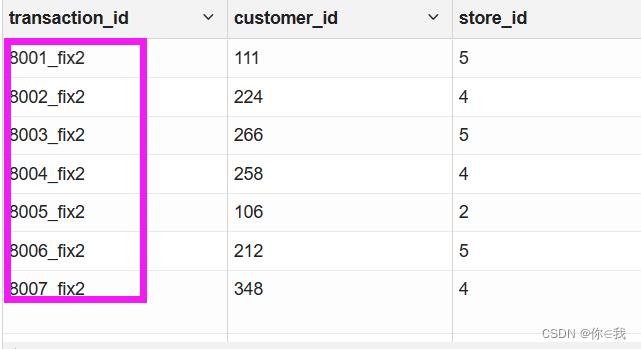
过滤掉store_review中没有评分的数据
查出有评分的数据
%hive
use shopping;
create view if not exists vm_store_review as
select *
from ext_store_review
where review_score <> '';
select * from vm_store_review;
找出PII (personal information identification‘个人信息识别’) 数据进行加密
%hive
use shopping;
drop view customer_detail;
create view vm_customer_details as
select
customer_id,first_name,unbase64(last_name)as last_name,unbase64(email) as email,
gender,unbase64(address) as address,
unbase64(concat(unbase64(credit_no),'hello')) as credit_no --二次加密
from ext_customer_details;
重新组织transaction数据按照日期YYYY-MM(按月)做分区
%hive
use shopping;
set hive.exec.dynamic.partition.mode=nonstrict;
with basetb as (
select row_number() over (partition by transaction_id order by transaction_id) as rn
, transaction_id
, customer_id
, store_id
, price
, product
, purchase_date
, purchase_time
, substr(purchase_date, 0, 7) as purchase_month
from ext_transaction_details)
insert overwrite table transaction_details partition (purchase_month)
select `if`(rn = 1, transaction_id, concat(transaction_id, '_fix', rn)) transaction_id
, customer_id
, store_id
, price
, product
, purchase_date
, purchase_time
, purchase_month
from basetb;
show partitions transaction_details;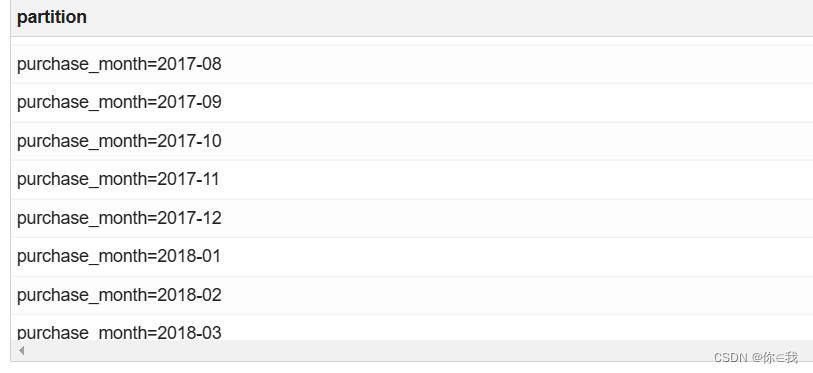
Customer分析
1.找出顾客最常用的信用卡
%hive
use shopping;
select credit_type, max(credit_type) counts
from ext_customer_details
group by credit_type
order by counts desc;
2.找出户客资料中排名前五的职位名称
select job, count(job) counts
from ext_customer_details
group by job
order by counts desc
limit 5;
3.在美国女性最常用的信用卡
%hive
use shopping;
select credit_type, count(credit_type) counts
from ext_customer_details
where gender = 'Female' and country='United States'
group by credit_type
order by counts desc;
4.按性别和国家进行客户统计
%hive
use shopping;
select country, gender,count(customer_id)
from ext_customer_details
group by gender, country;
Transaction
1.计算每月总收入
%hive
use shopping;
select substr(purchase_date,0,7) month,round(sum(price),2) sum
from ext_transaction_details
group by substr(purchase_date,0,7);

2.计算每个季度的总收入
with basetb as (
select concat_ws('-', cast(year(purchase_date) as string),
cast(quarter(purchase_date) as string)) as year_quarter,
price
from transaction_details)
select year_quarter ,sum(price) sumMoney from basetb group by year_quarter;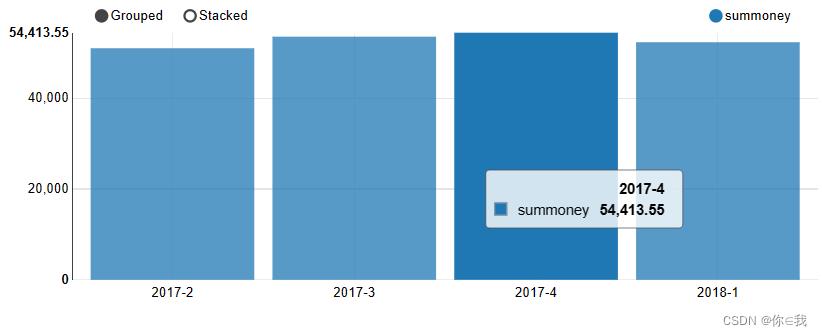
3.按年计算总收入
%hive
use shopping;
select year(purchase_date) years , round(sum(price),2) sum
from ext_transaction_details
group by year(purchase_date);
4.按工作日计算总收入
%hive
use shopping;
with basetb as (
select `dayofweek`(purchase_date) weekday, price
from transaction_details)
select case
when (weekday - 1) = 1 then '星期一'
when (weekday - 1) = 2 then '星期二'
when (weekday - 1) = 3 then '星期三'
when (weekday - 1) = 4 then '星期四'
when (weekday - 1) = 5 then '星期五'
end as weekday,
sum(price) sum
from basetb
group by weekday
having weekday between 2 and 6;
5.按时间段计算总收入(需要清理数据)
%hive
use shopping;
with basetb1 as (
select price,
purchase_time,
case
when purchase_time like '%AM' then split(purchase_time, '\\\\s+')[0]
when purchase_time like '%PM' then concat_ws(':',cast(`if`(
(cast(split(purchase_time, ':')[0] as int) + 12) == 24,0, (cast(split(purchase_time, ':')[0] as int) + 12)) as string)
, split(split(purchase_time, ':')[1], '\\\\s+')[0])
else purchase_time
end time_format
from transaction_details),
basetb2 as (select price,
purchase_time,
(cast(split(time_format, ':')[0] as decimal(4, 2)) +
cast(split(time_format, ':')[1] as decimal(4, 2)) / 60) purchase_time_num
from basetb1),
basetb3 as (select price,
purchase_time,
`if`(purchase_time_num > 5 and purchase_time_num <= 8, 'early morning',
`if`(purchase_time_num > 8 and purchase_time_num <= 11, ' morning',
`if`(purchase_time_num > 11 and purchase_time_num <= 13, 'noon',
`if`(purchase_time_num > 13 and purchase_time_num <= 18, 'afternoon',
`if`(purchase_time_num > 18 and purchase_time_num <= 22, 'evening','night'))))) as time_bucket
from basetb2)
select time_bucket, sum(price) sum
from basetb3
group by time_bucket;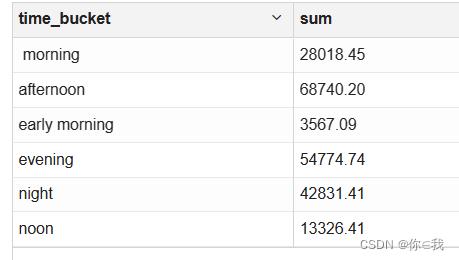
6.按时间段计算平均消费
%hive
use shopping;
with basetb1 as (
select price,
purchase_time,
case
when purchase_time like '%AM' then split(purchase_time, '\\\\s+')[0]
when purchase_time like '%PM' then concat_ws(':',cast(`if`(
(cast(split(purchase_time, ':')[0] as int) + 12) == 24,0, (cast(split(purchase_time, ':')[0] as int) + 12)) as string)
, split(split(purchase_time, ':')[1], '\\\\s+')[0])
else purchase_time
end time_format
from transaction_details),
basetb2 as (select price,
purchase_time,
(cast(split(time_format, ':')[0] as decimal(4, 2)) +
cast(split(time_format, ':')[1] as decimal(4, 2)) / 60) purchase_time_num
from basetb1),
basetb3 as (select price,
purchase_time,
`if`(purchase_time_num > 5 and purchase_time_num <= 8, 'early morning',
`if`(purchase_time_num > 8 and purchase_time_num <= 11, ' morning',
`if`(purchase_time_num > 11 and purchase_time_num <= 13, 'noon',
`if`(purchase_time_num > 13 and purchase_time_num <= 18, 'afternoon',
`if`(purchase_time_num > 18 and purchase_time_num <= 22, 'evening','night'))))) as time_bucket
from basetb2)
select time_bucket, avg(price) avg
from basetb3
group by time_bucket;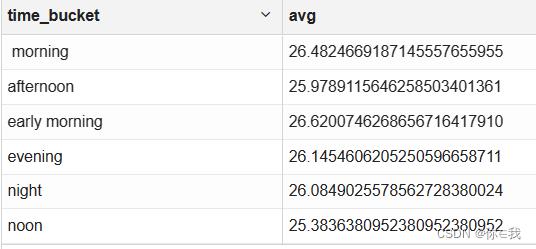
7.按工作日计算平均消费
%hive
use shopping;
with basetb as (
select `dayofweek`(purchase_date) weekday, price
from transaction_details)
select case
when (weekday - 1) = 1 then '星期一'
when (weekday - 1) = 2 then '星期二'
when (weekday - 1) = 3 then '星期三'
when (weekday - 1) = 4 then '星期四'
when (weekday - 1) = 5 then '星期五'
end weekday,
avg(price) avg
from basetb
group by weekday
having weekday between 2 and 6;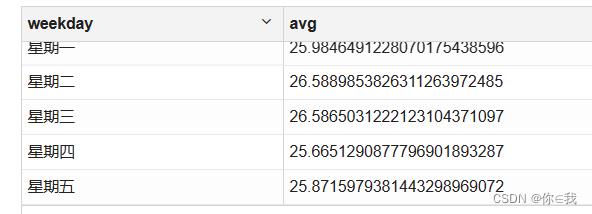
8.计算年、月、日的交易总数
%hive
use shopping;
select distinct purchase_date,
purchase_month,
year(purchase_date),
count(1) over (partition by year(purchase_date)) years,
count(1) over (partition by year(purchase_date),month(purchase_date)) months,
count(1) over (partition by year(purchase_date),month(purchase_date),day(purchase_date)) days
from transaction_details;
9.找出交易量最大的10个客户
%hive
use shopping;
select
customer_id,count(1) as num
from transaction_details
group by customer_id
order by num desc
limit 10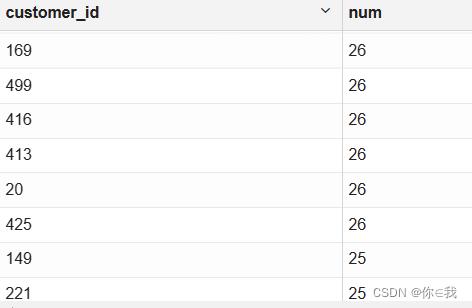
10.找出消费最多的前10位顾客
%hive
use shopping;
select customer_id,
sum(price) as sum
from transaction_details
group by customer_id
order by sum desc
limit 10
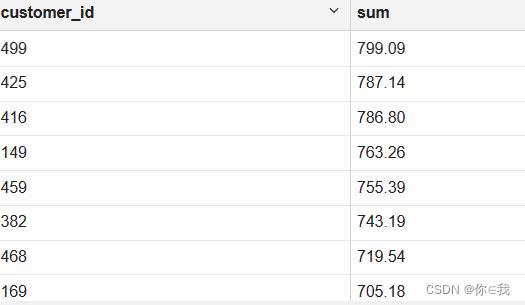
11.计该期间交易数量最少的用户
use shopping;
select customer_id, count(transaction_id)
from transaction_details
group by customer_id
order by count(transaction_id)
limit 1;
12.算每个季度的独立客户总数
%hive
use shopping;
with basetb as (
select distinct concat_ws('-', cast(year(purchase_date) as string),
cast(quarter(purchase_date) as string)) as year_quarter,
customer_id
from transaction_details)
select year_quarter, count(customer_id) counts
from basetb
group by year_quarter;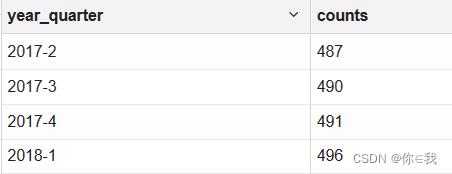
13.算每周的独立客户总数
%hive
use shopping;
with basetb as (
select distinct concat(cast(year(purchase_date) as string), '-', cast(weekofyear(purchase_date)as string)) weeks,
customer_id
from transaction_details)
select weeks, count(customer_id) counts
from basetb
group by weeks;
14.算整个活动客户平均花费的最大值
%hive
use shopping;
select customer_id,avg(price) avgs
from transaction_details
group by customer_id
order by avgs desc
limit 1;
15.计每月花费最多的客户
%hive
use shopping;
with basetb as (
select purchase_month,
customer_id,
sum(price) sum_price
from transaction_details
group by purchase_month, customer_id),
basetb2 as (
select purchase_month,
customer_id,
sum_price,
row_number() over (partition by purchase_month order by sum_price desc ) rn
from basetb)
select purchase_month, customer_id, sum_price
from basetb2
where rn = 1;
16.计每月访问次数最多的客户
%hive
use shopping;
with basetb as (
select purchase_month,
customer_id,
count(customer_id) counts
from transaction_details
group by purchase_month, customer_id),
basetb2 as (
select purchase_month,
customer_id,
counts,
row_number() over (partition by purchase_month order by counts desc ) rn
from basetb)
select purchase_month, customer_id, counts
from basetb2
where rn = 1;
17.总价找出最受欢迎的5种产品
select product,sum(price) sum
from transaction_details
group by product
order by sum desc
limit 5;

18.据购买频率找出最畅销的5种产品
select product,
count(1) counts
from transaction_details
group by product
order by counts desc
limit 5;
19.据客户数量找出最受欢迎的5种产品
select product,
count(distinct customer_id) counts
from transaction_details
group by product
order by counts desc
limit 5Store分析
1.按客流量找出最受欢迎的商店
%hive
use shopping;
select store_name, count(distinct customer_id) counts
from transaction_details td
join ext_store_details esd on td.store_id = esd.store_id
group by store_name
order by counts desc;
2.根据顾客消费价格找出最受欢迎的商店
%hive
use shopping;
select store_name, sum(price) sums
from transaction_details td
join ext_store_details esd on td.store_id = esd.store_id
group by store_name
order by sums desc;3.根据顾客交易情况找出最受欢迎的商店
%hive
use shopping;
select store_name, count(td.store_id) counts
from transaction_details td
join ext_store_details esd on td.store_id = esd.store_id
group by store_name
order by counts desc;4.根据商店和唯一的顾客id获取最受欢迎的产品
%hive
use shopping;
with basetb as (
select store_id, product, count(distinct customer_id) counts
from transaction_details
group by store_id, product),
basetb2 as (
select store_id,
product,
counts,
rank() over (partition by store_id order by counts desc ) as rn
from basetb)
select store_name, product, counts
from basetb2 tb2
join ext_store_details esd on tb2.store_id = esd.store_id
where rn = 1;5.获取每个商店的员工与顾客比
%hive
use shopping;
with t1 as (select count(1) c1, store_id
from transaction_details td
group by td.store_id)
select t1.store_id,
esd.store_name,
concat(substring(cast(esd.employee_number / t1.c1 as decimal(9, 8)) * 100.0, 0, 4), '%') proportion
from t1
join ext_store_details esd on t1.store_id = esd.store_id;
6.按年和月计算每家店的收入
%hive
use shopping;
select distinct *
from (
select store_id,
year(purchase_date) year,
sum(price) over (partition by year(purchase_date)) sum_year,
month(purchase_date) month,
sum(price) over (partition by year(purchase_date),month(purchase_date)) sum_month
from transaction_details
) tb; 
7.按店铺制作总收益饼图
%hive
use shopping;
select store_id,sum(price)
from transaction_details
group by store_id
8.找出每个商店最繁忙的时间段
%hive
use shopping;
with basetb1 as (
select store_id,
customer_id,
purchase_time,
case
when purchase_time like '%AM' then split(purchase_time, '\\\\s+')[0]
when purchase_time like '%PM' then concat_ws(':',
cast(`if`(
(cast(split(purchase_time, ':')[0] as int) + 12) == 24,
0,
(cast(split(purchase_time, ':')[0] as int) + 12)) as string)
, split(split(purchase_time, ':')[1], '\\\\s+')[0])
else purchase_time
end time_format
from transaction_details),
basetb2 as (select store_id,
customer_id,
purchase_time,
(cast(split(time_format, ':')[0] as decimal(4, 2)) +
cast(split(time_format, ':')[1] as decimal(4, 2)) / 60) purchase_time_num
from basetb1),
basetb3 as (select store_id,
customer_id,
purchase_time,
`if`(purchase_time_num > 5 and purchase_time_num <= 8, 'early morning',
`if`(purchase_time_num > 8 and purchase_time_num <= 11, 'morning',
`if`(purchase_time_num > 11 and purchase_time_num <= 13, 'noon',
`if`(purchase_time_num > 13 and purchase_time_num <= 18, 'afternoon',
`if`(purchase_time_num > 18 and purchase_time_num <= 22, 'evening',
'night'))))) as time_bucket
from basetb2)
select esd.store_name,
tb3.time_bucket,
count(customer_id) counts
from basetb3 tb3
join ext_store_details esd on tb3.store_id = esd.store_id
group by esd.store_name, time_bucket;9.找出每家店的忠实顾客
购买次数大于5,认为他是忠实粉丝
%hive
use shopping;
select *
from (
select store_id, customer_id, count(1) counts
from transaction_details
group by store_id, customer_id) tb
where tb.counts > 5; 
10.根据每位员工的最高收入找出明星商店
%hive
use shopping;
with base as
(
select store_id, sum(price) s
from transaction_details
group by store_id
)
select base.store_id,
base.s / store.employee_number en
from base
join ext_store_details store
on base.store_id = store.store_id
order by en desc
limit 1;Review分析
1.在ext_store_review中找出存在冲突的交易映射关系
%hive
use shopping;
with basetb as (
select row_number() over (partition by transaction_id) as row_number1, * from vm_store_review
)
select row_number1, a.transaction_id, a.store_id, b.store_id, a.review_score, b.review_score
from basetb a
join vm_store_review b on a.transaction_id = b.transaction_id
where row_number1 > 1;
2.了解客户评价的覆盖率
%hive
use shopping;
with t1 as (
select count(1) c1
from ext_store_review
where review_score <> ''
),
t2 as (
select count(1) c2
from ext_store_review
where review_score = ''
)
select concat(cast((c1 - c2) / c1 * 100 as decimal(4, 2)), '%') Coverage
from t1 join t2;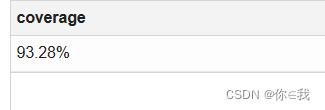
3.根据评分了解客户的分布情况
%hive
use shopping;
select concat(round(sum(case review_score when '1' then 1 else 0 end) / count(*) * 100, 2), '%') as one_score,
concat(round(sum(case review_score when '2' then 1 else 0 end) / count(*) * 100, 2), '%') as two_score,
concat(round(sum(case review_score when '3' then 1 else 0 end) / count(*) * 100, 2), '%') as three_score,
concat(round(sum(case review_score when '4' then 1 else 0 end) / count(*) * 100, 2), '%') as four_score,
concat(round(sum(case review_score when '5' then 1 else 0 end) / count(*) * 100, 2), '%') as five_score
from ext_store_review;
4.根据交易了解客户的分布情况
根据总金额
%hive
use shopping;
select country,
sum(price) sum_price
from transaction_details td
join ext_customer_details cd on td.customer_id = cd.customer_id
group by cd.country; 
5.客户给出的最佳评价是否总是同一家门店
%hive
use shopping;
select store_id, customer_id, count(customer_id) counts
from transaction_details td
join ext_store_review esr
on esr.transaction_id = td.transaction_id
where esr.review_score = 5
group by td.store_id, td.customer_id;

以上是关于Hive实战 --- 电子商务消费行为分析的主要内容,如果未能解决你的问题,请参考以下文章





